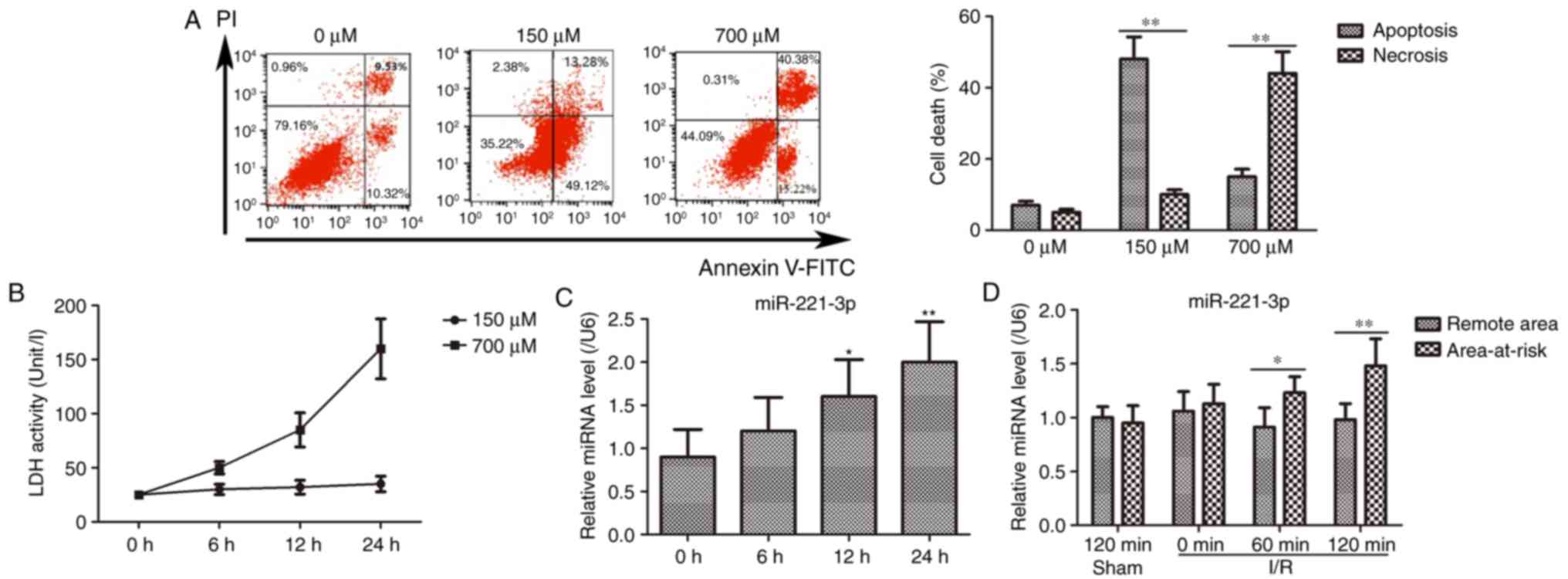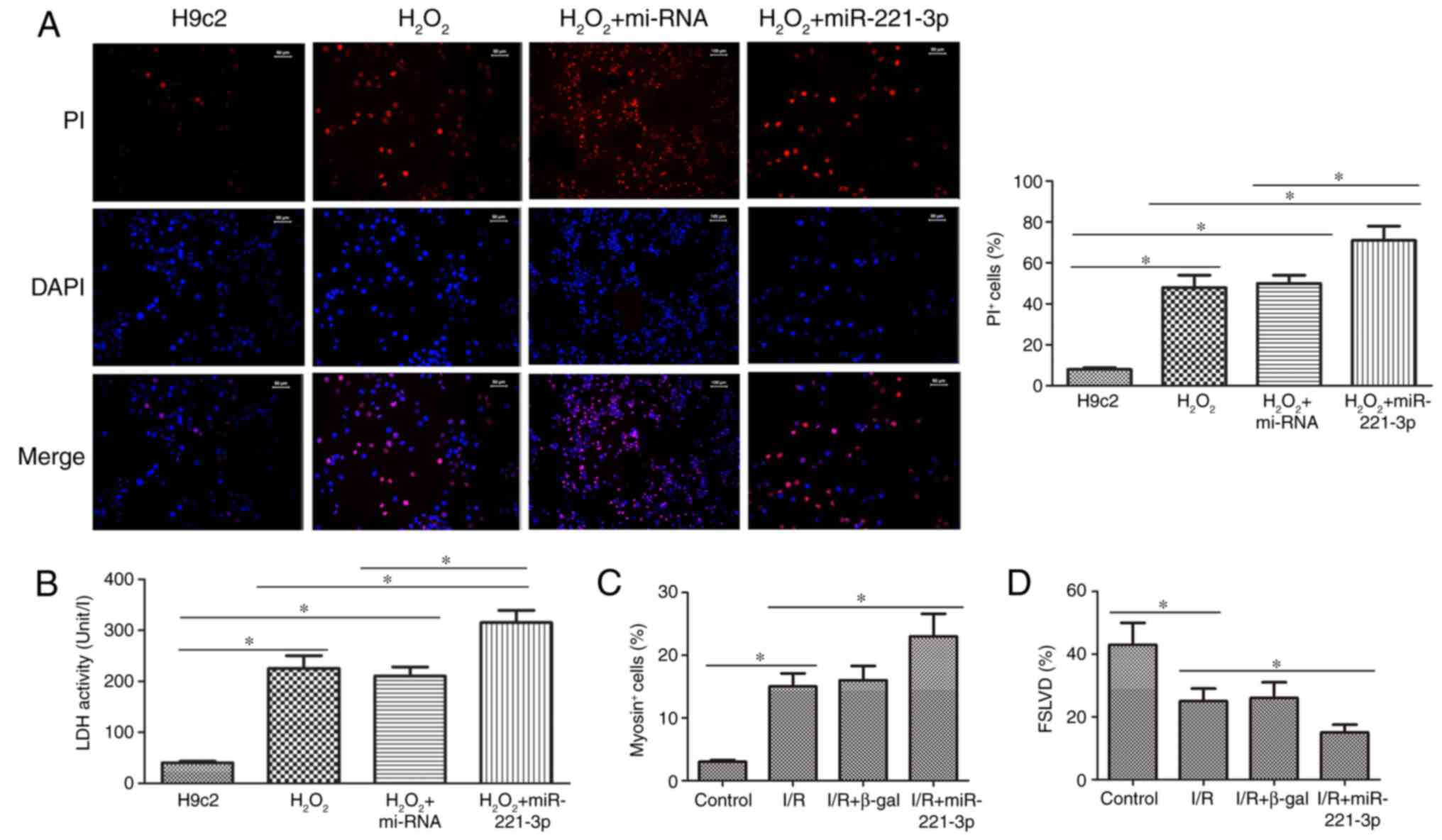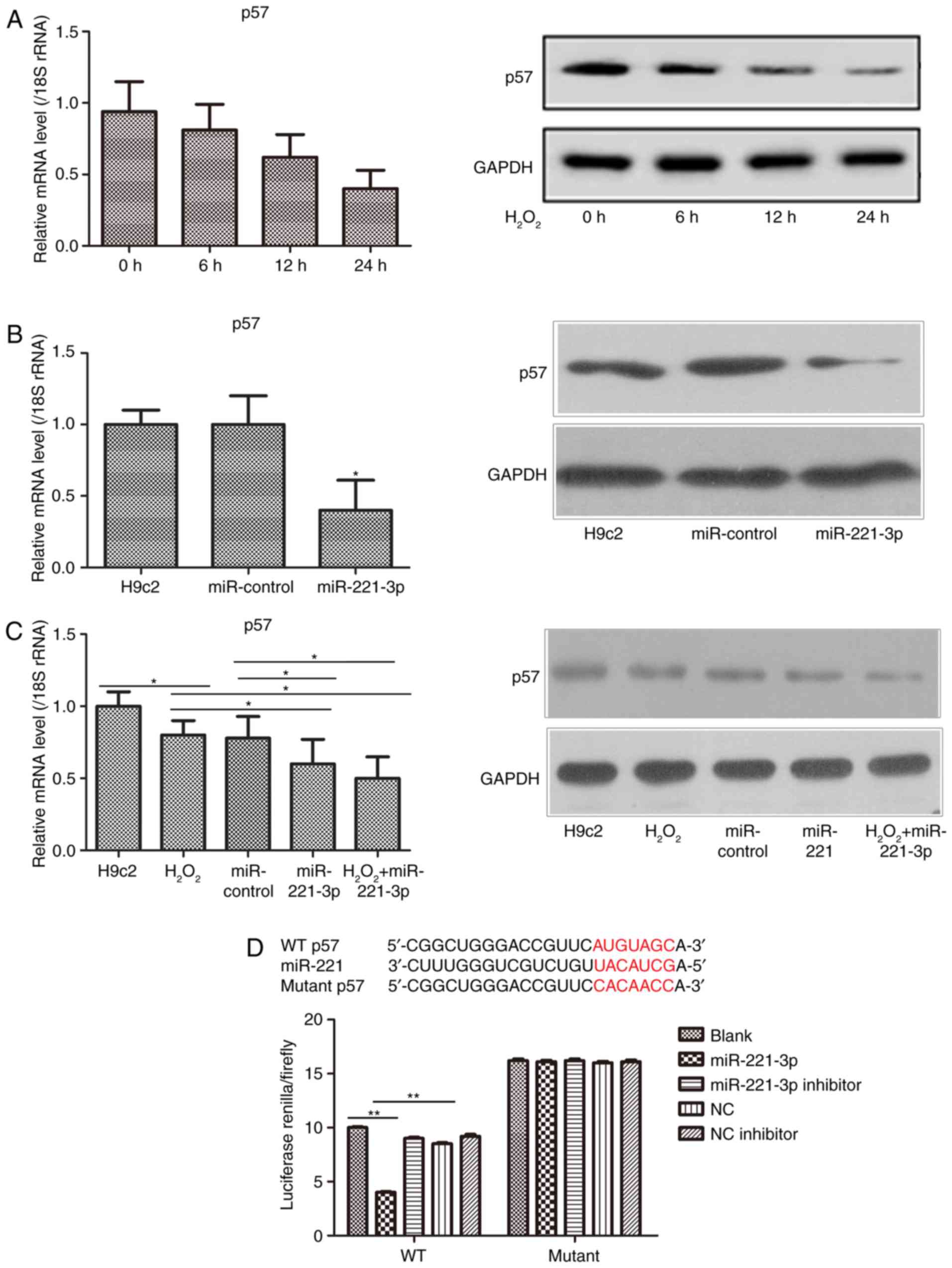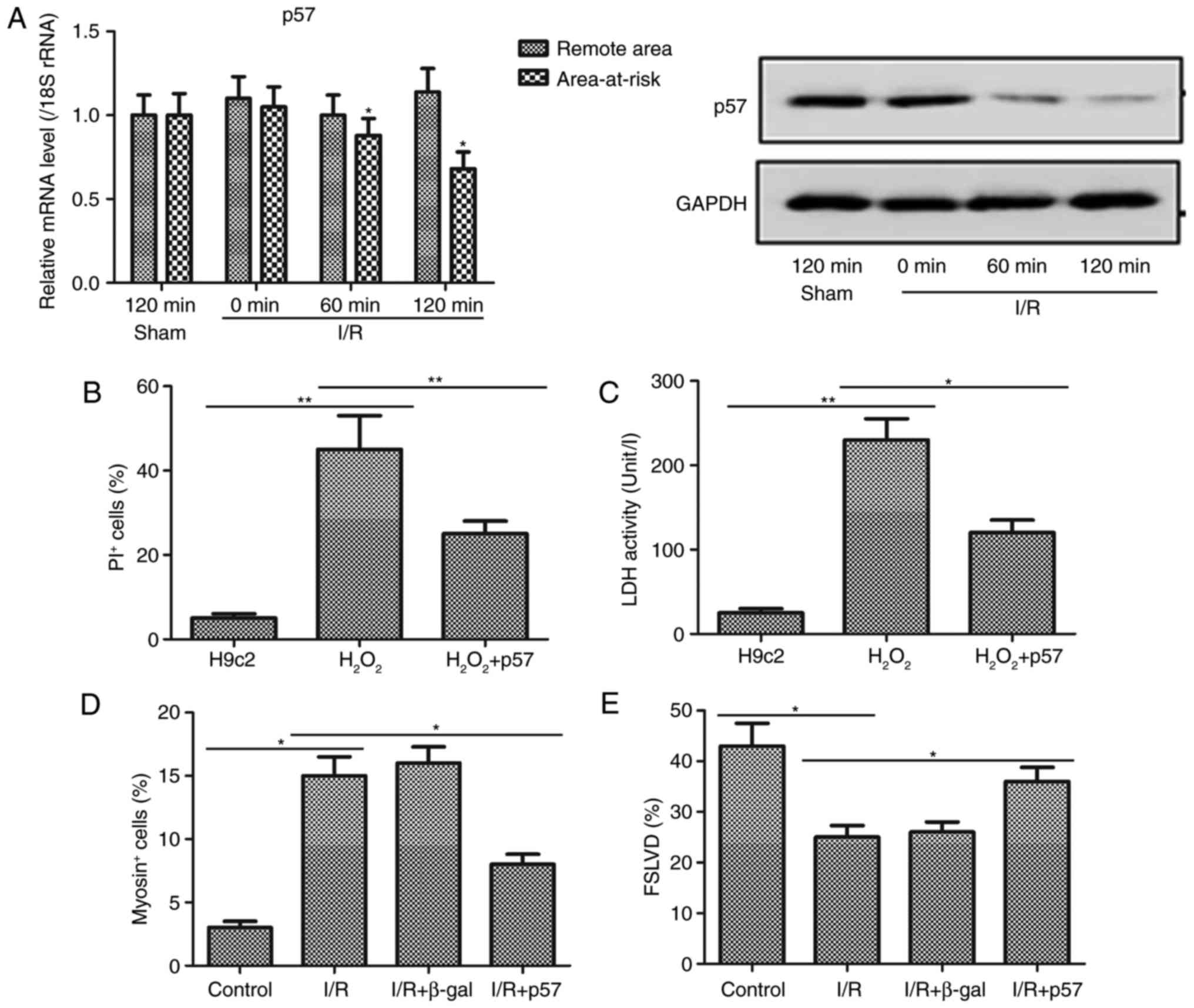|
1
|
Dongó E, Hornyák I, Benko Z and Kiss L:
The cardioprotective potential of hydrogen sulfide in myocardial
ischemia/reperfusion injury (Review). Acta Physiol Hung.
98:369–381. 2011. View Article : Google Scholar : PubMed/NCBI
|
|
2
|
Neri M, Riezzo I, Pascale N, Pomara C and
Turillazzi E: Ischemia/reperfusion injury following acute
myocardial infarction: A critical issue for clinicians and forensic
pathologists. Mediators Inflamm. 2017:70183932017. View Article : Google Scholar : PubMed/NCBI
|
|
3
|
Wernly JA: Ischemia, reperfusion, and the
role of surgery in the treatment of cardiogenic shock secondary to
acute myocardial infarction: An interpretative review. J Surg Res.
117:6–21. 2004. View Article : Google Scholar : PubMed/NCBI
|
|
4
|
Bagheri F, Khori V, Alizadeh AM,
Khalighfard S, Khodayari S and Khodayari H: Reactive oxygen
species-mediated cardiac-reperfusion injury: Mechanisms and
therapies. Life Sci. 165:43–55. 2016. View Article : Google Scholar : PubMed/NCBI
|
|
5
|
Hoffman JW Jr, Gilbert TB, Poston RS and
Silldorff EP: Myocardial reperfusion injury: Etiology, mechanisms,
and therapies. J Extra Corpor Technol. 36:391–411. 2014.
|
|
6
|
Johnson AP, Parlow JL, Whitehead M, Xu J,
Rohland S and Milne B: Body mass index, outcomes, and mortality
following cardiac surgery in Ontario, Canada. J Am Heart Assoc.
4:e0021402015. View Article : Google Scholar : PubMed/NCBI
|
|
7
|
Braunersreuther V and Jaquet V: Reactive
oxygen species in myocardial reperfusion injury: From
physiopathology to therapeutic approaches. Curr Pharm Biotechnol.
13:97–114. 2012. View Article : Google Scholar
|
|
8
|
Davis-Dusenbery BN and Hata A: Mechanisms
of control of microRNA biogenesis. J Biochem. 148:381–392.
2010.PubMed/NCBI
|
|
9
|
Liu X, Fortin K and Mourelatos Z:
MicroRNAs: Biogenesis and molecular functions. Brain Pathol.
18:113–121. 2008. View Article : Google Scholar : PubMed/NCBI
|
|
10
|
Devaux Y, Creemers EE, Boon RA, Werfel S,
Thum T, Engelhardt S, Dimmeler S and Squire I: Circular RNAs in
heart failure. Eur J Heart Fail. 27:2017.
|
|
11
|
Pan ZW, Lu YJ and Yang BF: MicroRNAs: A
novel class of potential therapeutic targets for cardiovascular
diseases. Acta Pharmacol Sin. 31:1–9. 2010. View Article : Google Scholar
|
|
12
|
Frost RJ and van Rooij E: MiRNAs as
therapeutic targets in ischemic heart disease. J Cardiovasc Transl
Res. 3:280–289. 2010. View Article : Google Scholar : PubMed/NCBI
|
|
13
|
Yang J, Chen L, Yang J, Ding J, Li S, Wu
H, Zhang J, Fan Z, Dong W and Li X: MicroRNA-22 targeting CBP
protects against myocardial ischemia-reperfusion injury through
anti-apoptosis in mice. Mol Biol Rep. 41:555–561. 2014. View Article : Google Scholar
|
|
14
|
Lima J Jr, Batty JA, Sinclair H and
Kunadian V: MicroRNAs in ischemic heart disease: From
pathophysiology to potential clinical applications. Cardiol Rev.
25:117–25. 2017. View Article : Google Scholar
|
|
15
|
Kukreja RC, Yin C and Salloum FN:
MicroRNAs: New players in cardiac injury and protection. Mol
Pharmacol. 80:558–564. 2011. View Article : Google Scholar : PubMed/NCBI
|
|
16
|
Yu S and Li G: MicroRNA expression and
function in cardiac ischemic injury. J Cardiovasc Transl Res.
3:241–245. 2010. View Article : Google Scholar : PubMed/NCBI
|
|
17
|
Coskunpinar E, Cakmak HA, Kalkan AK,
Tiryakioglu NO, Erturk M and Ongen Z: Circulating miR-221-3p as a
novel marker for early prediction of acute myocardial infarction.
Gene. 591:90–96. 2016. View Article : Google Scholar : PubMed/NCBI
|
|
18
|
He XM, Zheng YQ, Liu SZ, Liu Y, He YZ and
Zhou XY: Altered plasma microRNAS as novel biomarkers for
arteriosclerosis obliterans. J Atheroscler Thromb. 23:196–206.
2016. View Article : Google Scholar
|
|
19
|
Timotin A, Pisarenko O, Sidorova M,
Studneva I, Shulzhenko V, Palkeeva M, Serebryakova L, Molokoedov A,
Veselova O, Cinato M, et al: Myocardial protection from
ischemia/reperfusion injury by exogenous galanin fragment.
Oncotarget. 8:21241–2152. 2017. View Article : Google Scholar : PubMed/NCBI
|
|
20
|
Livak KJ and Schmittgen TD: Analysis of
relative gene expression data using real-time quantitative PCR and
the 2−ΔΔCT method. Methods. 25:402–408. 2001. View Article : Google Scholar
|
|
21
|
Wang K, Long B, Li N, Li L, Liu CY, Dong
YH, Gao JN, Zhou LY, Wang CQ and Li PF: MicroRNA-2861 regulates
programmed necrosis in cardiomyocyte by impairing adenine
nucleotide translocase 1 expression. Free Radic Biol Med. 91:58–67.
2016. View Article : Google Scholar
|
|
22
|
Burghardt TP, Sun X, Wang Y and Ajtai K:
Auxotonic to isometric contraction transitioning in a beating heart
causes myosin step-size to down shift. PLoS One. 12:e01746902017.
View Article : Google Scholar : PubMed/NCBI
|
|
23
|
Tao L, Jia L, Li Y, Song C and Chen Z:
Recent advances of adapter proteins in the regulation of heart
diseases. Heart Fail Rev. 22:99–107. 2017. View Article : Google Scholar
|
|
24
|
Yang Q, He GW, Underwood MJ and Yu CM:
Cellular and molecular mechanisms of endothelial
ischemia/reperfusion injury: Perspectives and implications for
postischemic myocardial protection. Am J Transl Res. 8:765–777.
2016.PubMed/NCBI
|
|
25
|
Wang L, Niu X, Hu J, Xing H, Sun M, Wang
J, Jian Q and Yang H: After myocardial ischemia-reperfusion,
miR-29a, and Let7 could affect apoptosis through regulating IGF-1.
Biomed Res Int. 2015:2454122015. View Article : Google Scholar
|
|
26
|
Zhao Y, Ponnusamy M, Dong Y, Zhang L, Wang
K and Li P: Effects of miRNAs on myocardial apoptosis by modulating
mitochondria related proteins. Clin Exp Pharmacol Physiol.
44:431–440. 2017. View Article : Google Scholar
|
|
27
|
Makhdoumi P, Roohbakhsh A and Karimi G:
MicroRNAs regulate mitochondrial apoptotic pathway in myocardial
ischemia-reperfusion-injury. Biomed Pharmacother. 84:1635–1644.
2016. View Article : Google Scholar : PubMed/NCBI
|
|
28
|
Liu YF, Chu YY, Zhang XZ, Zhang M, Xie FG,
Zhou M, Wen HH and Shen HH: TGFβ1 protects myocardium from
apoptosis and oxidative damage after ischemia reperfusion. Eur Rev
Med Pharmacol Sci. 21:1551–1558. 2017.PubMed/NCBI
|
|
29
|
Fornari F, Gramantieri L, Ferracin M,
Veronese A, Sabbioni S, Calin GA, Grazi GL, Giovannini C, Croce CM,
Bolondi L and Negrini M: MiR-221 controls CDKN1C/p57 and CDKN1B/p27
expression in human hepatocellular carcinoma. Oncogene.
27:5651–5661. 2008. View Article : Google Scholar : PubMed/NCBI
|
|
30
|
Rodríguez I, Coto E, Reguero JR, González
P, Andrés V, Lozano I, Martín M, Alvarez V and Morís C: Role of the
CDKN1A/p21, CDKN1C/p57, and CDKN2A/p16 genes in the risk of
atherosclerosis and myocardial infarction. Cell Cycle. 6:620–625.
2007. View Article : Google Scholar : PubMed/NCBI
|
|
31
|
Haley SA, Zhao T, Zou L, Klysik JE,
Padbury JF and Kochilas LK: Forced expression of the cell cycle
inhibitor p57Kip2 in cardiomyocytes attenuates
ischemia-reperfusion injury in the mouse heart. BMC Physiol.
8:42008. View Article : Google Scholar
|


















